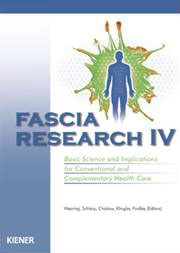Fascia Research IV
Basic Science and Implications for Conventional and Complementary
- ISBN: 9783943324099
- 2015, 278 pages
48,50 €
incl. VAT
plus shipping costs
Depending on the delivery address VAT may vary at checkout.
Delivery time: ca. 1 - 3 days
Description
Fascia Research – Basic Science and Implications for Conventional and Complementary Health Care by editors Thomas W. Findley, Robert Schleip et al.
Fascia is the soft tissue component of the connective tissue system that permeates the human body.
It forms a whole body continuous three-dimensional matrix of structural support.
It interpenetrates and surrounds all organs, muscles, bones and nerve fibers, creating a unique environment for body systems functioning.
There is a substantial body of research on connective tissue generally focused on specialized genetic and molecular aspects of the extracellular matrix.
The study of fascia and its function as an organ of support has advanced since the Fascia Research Congresses in 2007, 2009, 2012 and 2015.
The purpose of those conference books is to organize relevant information for scientists involved in the research of the bodys connective tissue matrix (fascia) as well as professionals involved in the therapeutic manipulation of this body wide structural fabric.
It includes background full text papers from a wide range of journals and abstracts presented at the International Fascia Research Congresses, the most recent one in Washington D.C. in September 2015.
The topics are among others:
Fluid Dynamics
Cytology & Histology
Mechanotransduction and Biomechanics
Gross Anatomy
Surgery and Scars
Pathology
Pain and Innervation
Therapy
Research Methods, Imaging and Hypotheses
New scientific findings reported at the congresses include:
Extracellular fluid pressure gradients meaintain function in soft tissues as well as bone
In vivo tissue streching causes changes in the fibroblast nuclear structure
Changes in the fibroblast can affect stiffness and viscosity of ceonnective tissue within minutes
Mechanical forces control embryological development as well as adult cell function
The structure of extracellular fibers in muscular connective tissue affects its function
Fascial connection between muscles can be seen in anatomical dissection and in living tissue
Hyaluronic acid provides a lubricating layer beween muscle and deep fascia
Connections between a tendon and its sheath move up to 2 centimeters
Loading and recovery of ceonnctive tissue in tendons and its implications for therapy
Mechanism of fascial and muscle pain
Massage activates cellular pathways responsive to mechanical interventions
Cellular models and direct imaging of tissue effects of clinical interventions
New imaging techniques of ultrasound and second harmonic generation laser microscopy
and other topics.
The previous conference books for 2007 and 2009 Vol. I -III are also available.
Author


